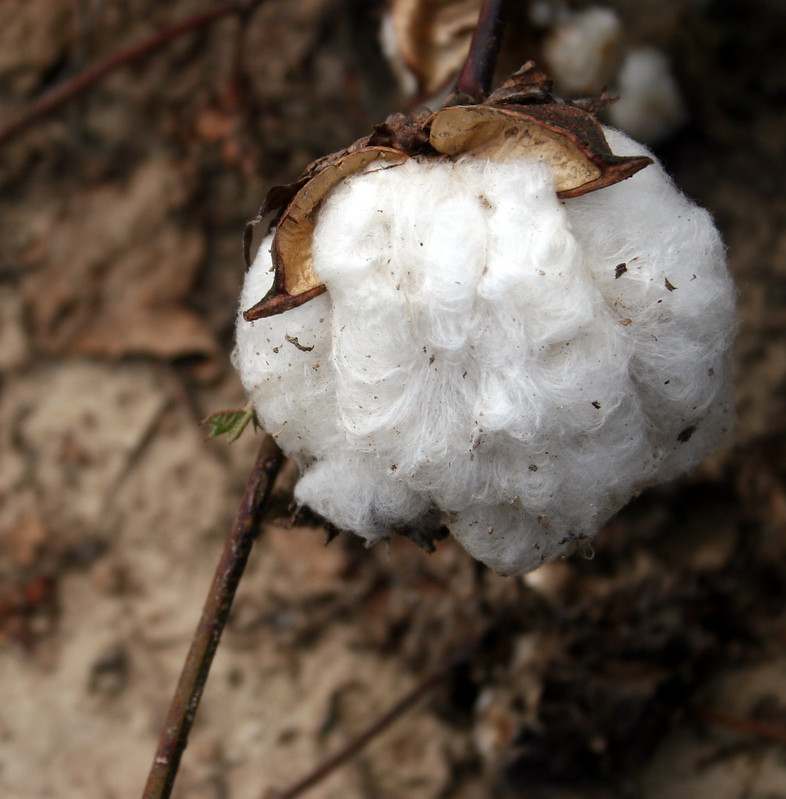Sept. 24, 2021
As cool weather descends, cotton growers enter the ‘waiting game’ phase
By Ryan McGeeney
U of A System Division of Agriculture
Fast Facts:
- Cool weather means cotton maturation will slow
- 410,000 acres of Arkansas cotton planted this year
- Growers will time defoliants to maximize picker efficiency
(541 words)
LITTLE ROCK — As overnight low temperatures fell into the 50s throughout much of Arkansas this week, cotton growers began doing the math.
Bill Robertson, extension cotton agronomist for the University of Arkansas System Division of Agriculture, said that with the arrival of fall weather, the final maturation of cotton plants will slow considerably — something growers will need to factor in if they wish to complete harvest by Nov. 1.
“Growing cotton isn’t a sprint, it’s a long-distance race,” Robertson said. “The plant is still working hard, but when the nighttime temperatures fall, we go from a plant that’s running hard to a plant that’s just sort of walking around, looking at the trees.”
Growers must weigh the use of chemical defoliants, which will prime the plants for picking machines to come through fields and collect the cotton bolls, against the likelihood of bad weather sweeping through unannounced.
“Cotton plants are a lot more weather-proof with the leaves still on them,” Robertson said. “So you don’t want to get too far ahead of your picker. Most of these growers have a lot more acreage than can be harvested in a single month.”
Hanging over the day-to-day planning is the likelihood of regularly wet weather returning in November. And so, the race begins.
Historically, Robertson said, most Arkansas cotton fields were picked twice.
“We’d put the picker in the fields before all the bolls were open because we had to get started,” he said, explaining that bolls of the first-planted cotton often begin to open even as those of the later-planted cotton remain closed.
“So we’d have to go back through that same acreage again to get the bolls that opened after the first picking,” Robertson said. “Some people picked all of their cotton acres twice.”
As picking machines became more expensive — some pickers costing nearly $1 million — growers became wary of placing unnecessary wear and tear on them.
“There are only so many hours on a machine, whether you’re picking a crop once or twice,” Robertson said. “So we try to get everything in one pass.”
Arkansas growers planted about 410,000 acres of cotton in 2021, a steep drop-off from the approximately 525,000 acres they planted in 2020, according to the U.S. Department of Agriculture.
Throughout the summer, Arkansas growers managed to reap the rewards of several major gulf storms — most notably, Hurricane Ida in late August — that passed near enough to the state to lower temperatures and break the stagnant humidity without bringing the attendant heavy rains and wind damage suffered by Louisiana, Mississippi and other neighboring states.
With the Arkansas corn harvest about three-fourths complete and the rice harvest nearly halfway done, soybean and cotton growers find themselves on one end of the meteorological wish list, while pasture managers and other producers find themselves on the other, Robertson said.
“When we look just at cotton, we’re to a point now where we really don’t want rain — let alone a hurricane,” he said. “The cotton is mature for the most part, and the cool temperatures are going to shut the maturation process down. It’s basically a drying process after that.
“Our livestock and forage people, they still need rain,” Robertson said. “There’s always somebody who wants rain, and somebody who doesn’t.”
To learn about extension programs in Arkansas, contact your local Cooperative Extension Service agent or visit www.uaex.uada.edu. Follow us on Twitter and Instagram at @AR_Extension. To learn more about Division of Agriculture research, visit the Arkansas Agricultural Experiment Station website: https://aaes.uark.edu. Follow on Twitter at @ArkAgResearch. To learn more about the Division of Agriculture, visit https://uada.edu/. Follow us on Twitter at @AgInArk.
About the Division of Agriculture
The University of Arkansas System Division of Agriculture’s mission is to strengthen agriculture, communities, and families by connecting trusted research to the adoption of best practices. Through the Agricultural Experiment Station and the Cooperative Extension Service, the Division of Agriculture conducts research and extension work within the nation’s historic land grant education system.
The Division of Agriculture is one of 20 entities within the University of Arkansas System. It has offices in all 75 counties in Arkansas and faculty on five system campuses.
Pursuant to 7 CFR § 15.3, the University of Arkansas System Division of Agriculture offers all its Extension and Research programs and services (including employment) without regard to race, color, sex, national origin, religion, age, disability, marital or veteran status, genetic information, sexual preference, pregnancy or any other legally protected status, and is an equal opportunity institution.
# # #
